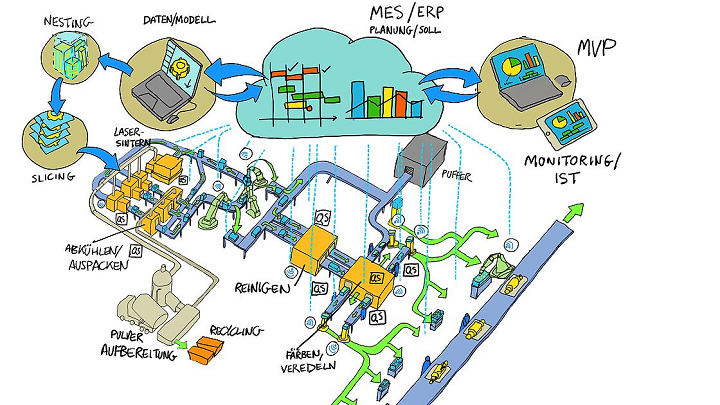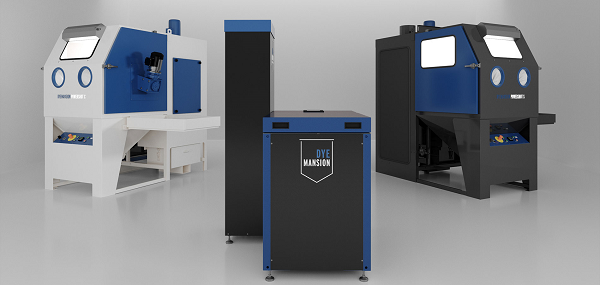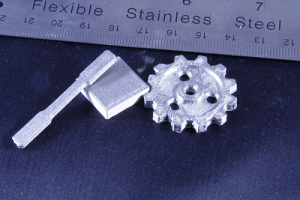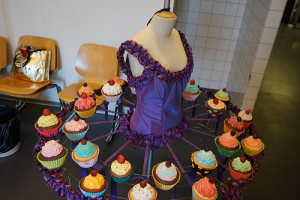Formnext launches 2020 3D printing Start-up Challenge
POLYLINE Project: Developing Digital Production Line for 3D Printing Spare & Series Automotive Parts
Because 3D printing can ensure complex structures and geometry, mass production of individualized products seems closer than ever. But, since standards are somewhat lacking across process chains, and automated levels of handling and transport processes are low, it’s only possible to achieve horizontal and vertical AM integration in production lines on a limited basis. Additional obstacles include limited monitoring and a lack of transparency across the process chain, due to a non-continuous digital data chain at lots of interfaces. But the potential benefits of integrating AM into assembly and series production lines in the automotive industry are great, which is why the POLYLINE project was launched.
 With 10.7 Mio. Euro in funding by the German Federal Ministry of Education and Research (BMBF), this “lighthouse project” is bringing together 15 industrial, science, and research partners from across Germany with the shared goal of creating a digital production line for 3D printed spare and series automotive parts.
With 10.7 Mio. Euro in funding by the German Federal Ministry of Education and Research (BMBF), this “lighthouse project” is bringing together 15 industrial, science, and research partners from across Germany with the shared goal of creating a digital production line for 3D printed spare and series automotive parts.
The three-year project officially began at a kick-off meeting of the consortium partners this spring at the Krailling headquarters of industrial 3D printing provider EOS, which is leading the project. The other 14 partners are:
- The BMW Group,
- Grenzebach Maschinenbau GmbH,
- 3YOURMIND,
- Additive Marking GmbH,
- DyeMansion GmbH,
- Bernd Olschner GmbH,
- Optris,
- Krumm-tec,
- Paderborn University,
- Fraunhofer IGCV,
- Fraunhofer IML,
- TU Dortmund University,
- University of Augsburg, and
- University of Duisburg-Essen
BMBF is funding POLYLINE as part of the “Photonics Research Germany – Light with a Future” program in order to set up AM as a solid alternative for series production. The resulting next-generation digital production line will 3D print plastic automotive parts in an aim to complement more traditional production techniques, like casting and machining, with high-throughput systems.
The project is looking to disrupt the digital and physical production line system, and is using an interesting approach to do so that, according to a press release, “takes a holistic view and implements all required processes.” To succeed, all of the quality criteria and central characteristic values from the CAD model to the printed part need to be recorded and documented, and individual production sub-processes, like the selective laser sintering, cooling, and post-processing, will be automated and added to the production line. For the first time, all technological elements of the SLS production chain will be linked as a result.
Per the application partner’s requirements, the production line will be realized with “a high degree of maturity,” and uses cases for POLYLINE will include large amounts of both serial and customized components.
Each partner will add its own contribution to the POLYLINE project. Beginning with the leader, the EOS P 500 system will have real-time monitoring and automated loading of exchange frames added to its features; the printer will also be embedded in an automatic powder handling system. Premium automotive manufacturer the BMW Group, already familiar with 3D printing, has a massive production network of 31 plants in 15 countries, and is creating a catalog of requirements for the project to make sure that the new line will meet automotive industry standards. Additionally, the demonstrator line will be set up near its Additive Manufacturing Campus, and cause-and-effect relationships will be jointly researched.
Industrial process automation specialist Grenzebach will be responsible for material flow and transport between AM processes, as well as helping to develop automated hardware and software interfaces for these processes. 3YOURMIND is setting up a data-driven operating model, which will include “qualified digital parts inventories, orders processing, jobs and post-processing planning and execution, material management, and quality control,” while software solutions developer Additive Marking is focusing on quality management optimization and resource efficiency.
Post-processing specialist DyeMansion will develop a process for certified, UV-stable automotive colors, create Industry 4.0-ready solutions for cleaning and mechanical surface treatment with its PolyShot Surfacing (PSS) process, and contribute its Print-to-Product platform’s MES connectivity. Bernd Olschner GmbH will offer its customer-specific industrial cleaning solutions, Optris will make fast pyrometers and special thermal imaging cameras adapted for plastic SLS 3D printing, and air filter systems manufacturer Krumm-tec will work to upgrade the manual object unpacking process.
Along with other project partners, Paderborn University is “working on the horizontal process chain for the integration of additive manufacturing in a line process,” while the Fraunhofer Institute for Casting, Composite and Processing-Technology IGCV is developing a concept for POLYLINE production planning and control, which will be tested in a simulation study for scalability. The Fraunhofer Institute for Material Flow and Logistics IML will work on “the physical concatenation of process steps,” paying specific attention to flexibly linking the former manual upstream and downstream AM processes.
TU Dortmund University will help apply deep learning, and implicit geometric modeling, for data preparation and analysis, along with online monitoring and quality management, in order to achieve sustainable automation and efficiency for the project. The University of Augsburg’s Chair of Digital Manufacturing works to integrate AM processes into current production methods, and will apply its expertise in this area to the POLYLINE project, helping to develop strong vertical process chains. Finally, the University of Duisburg-Essen will focus on creating quality assurance for the material system, and its laser sintering process.
Discuss this and other 3D printing topics at 3DPrintBoard.com or share your thoughts in the Facebook comments below.
The post POLYLINE Project: Developing Digital Production Line for 3D Printing Spare & Series Automotive Parts appeared first on 3DPrint.com | The Voice of 3D Printing / Additive Manufacturing.
15 industrial and academic partners come together for “breakthrough” POLYLINE project
The 2nd TÜV SÜD Additive Manufacturing Conference aims to explore industrial readiness
80 additive manufacturing experts predict the 3D printing trends to watch in 2020
3D Printing Industry Review of the Year July 2019
3YOURMIND challenges physical warehouses with introduction of Digital AM Inventory
Interview with Alexandre Donnadieu-Deray of 3YOURMIND
Alexandre Donnadieu-Deray is the Managing Director of 3YOURMIND.
Give us some understanding on your career background?
I joined 3YOURMIND 2 years ago. I was a consultant at Capgemini Invent for 5 years. I was focused on consulting for digital products and organizations at the time. This is where I learned about 3YOURMIND. I was able to be a consultant for them as well while at Capgemini.

What got you interested in the industry of 3D Printing?
I was doing a lot of strategy and addressing needs to improve companies on a large scale. I was aware of 3D Printing and I saw the agility of this field. It requires a smart thought process at looking into manufacturing processes. 3D Printing is a very disruptive methodology. It is very exciting to think through this. Software and digital is very important. This is the sandbox for other manufacturing settings.
What got you interested in 3YOURMIND?
Two things initially got me excited about 3YOURMIND. Firstly, I was interested in the product. It is the first of its kind in the market with such a thorough thought process. The credibility of the product was great. The culture of 3YOURMIND is also great. It is a fun and interesting place. We move dynamically and with agility.
How does the origin of the company in terms of global culture affect operations?
I would say transparency towards customers is highly valued. We speak frankly and straightforwardly. Software is an industry that typically focuses only on the technical aspects of their product. We go away from the typical mindset. Creativity is very important and highly valued. We try to coach individuals on how to best prepare a solution for their business.
What is the DNA of 3YOURMIND?
I would say it is related to the name. There is a lot of openness and creativity. Idea meritocracy is vital. Listening is very important as well. Humility is very important as well in how we operate.
How do you all navigate between trade-offs in tech vs. customer experience?
Firstly we have agility in terms of squads per module. This refers to our teams dedicated to various issues per every business we consult for. Secondly, project managers are very important. Balancing daily operations and long term vision is vital. Lastly, how we approach product design is focused on collaborating and building with the customer.
What is the five year vision of 3YOURMIND?
The goal is to be the software of reference for automating the shop of the future. Digitization will be occuring at a rapid level. Planning towards the factory of the future is what we want to specialize in.
The post Interview with Alexandre Donnadieu-Deray of 3YOURMIND appeared first on 3DPrint.com | The Voice of 3D Printing / Additive Manufacturing.
3D Printing News Briefs: April 6, 2019
We’re starting off today’s 3D Printing News Briefs with a product launch announcement – 3YOURMIND launched the full version of its Agile MES software software this week at AMUG 2019. Moving on, Sintratec will present its latest SLS 3D printer at RAPID + TCT next month in Detroit, Tiamet3D has joined Ultimaker’s material alliance program, and Sciaky entered into an agreement with KTM Consultants. Xometry just announced some important certifications, and nScrypt is 3D printing titanium parts. Moving on to the world of art and theatre, the Zurich Opera House is 3D printing props, and artist Andrea Salvatori worked with WASP to create a 3D printed art collection.
3YOURMIND Launched Agile Manufacturing Execution System (MES) Software
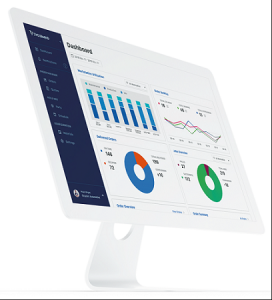 After spending five years providing order management systems to scale for some of the industry’s AM leaders, 3YOURMIND has finally moved its software solutions to a production environment with the launch of its Agile Manufacturing Execution System (MES) earlier this week at AMUG 2019. The software uses smart part prioritization, rapid scheduling, order tracking, and custom AM workflow creation to improve machine utilization and make production more efficient, and an Early Access Program (EAP) allowed the company to receive direct feedback on its Agile MES software from representatives at companies like EOS and Voestalpine. The next step will be working to finalize machine connectivity.
After spending five years providing order management systems to scale for some of the industry’s AM leaders, 3YOURMIND has finally moved its software solutions to a production environment with the launch of its Agile Manufacturing Execution System (MES) earlier this week at AMUG 2019. The software uses smart part prioritization, rapid scheduling, order tracking, and custom AM workflow creation to improve machine utilization and make production more efficient, and an Early Access Program (EAP) allowed the company to receive direct feedback on its Agile MES software from representatives at companies like EOS and Voestalpine. The next step will be working to finalize machine connectivity.
“For Agile Manufacturing, the Agile MES will need to both GET and PUSH data from all major AM machines and post-processing systems. We are already integrating the data from several vendors into our software and expect to support all major machines,” explained 3YOURMIND’s CEO Stephan Kühr. “Receiving and processing machine data allows us to provide the documentation that is needed for quality assurance and to increase the repeatability of additive manufacturing. Pushing data directly to machines will be the key to automating production.”
Sintratec Showcasing New SLS 3D Printer at RAPID + TCT
 A few months ago, Swiss SLS 3D printer manufacturer Sintratec introduced its scalable, modular Sintratec S2. Now, the company will be presenting the printer in the US for the first time next month at RAPID + TCT in Detroit, which will also be Sintratec’s first time attending the massive event. What makes the Sintratec S2 stand out is its closed-loop workflow, as the complete system covers every process with its three modules: the Laser Sintering Station (LSS), the Material Core Unit (MCU), and the Material Handling Station (MHS). The 3D printer offers quick material changes, a 4K camera for print monitoring, improved ergonomics, and effective heat distribution through its cylindrical printing area and ring lamps.
A few months ago, Swiss SLS 3D printer manufacturer Sintratec introduced its scalable, modular Sintratec S2. Now, the company will be presenting the printer in the US for the first time next month at RAPID + TCT in Detroit, which will also be Sintratec’s first time attending the massive event. What makes the Sintratec S2 stand out is its closed-loop workflow, as the complete system covers every process with its three modules: the Laser Sintering Station (LSS), the Material Core Unit (MCU), and the Material Handling Station (MHS). The 3D printer offers quick material changes, a 4K camera for print monitoring, improved ergonomics, and effective heat distribution through its cylindrical printing area and ring lamps.
“The Sintratec S2 will boost the design of applications and gives the user the opportunity to set foot in small series production as well. And that for an unusually attractive price-performance ratio,” said Sintratec CEO Dominik Solenicki.
“With the Sintratec S2 solution we will be opening new opportunities for companies of any size.”
The price for the Sintratec S2 starts at $39,900, and you can see it for yourself at Sintratec’s booth 1753 at RAPID + TCT from May 20-23.
Tiamet 3D Joins Ultimaker’s Material Alliance Program
 Last year, Dutch 3D printing specialist Tiamet 3D, founded in late 2014, worked with Finland-based Carbodeon to develop the first nanodiamond-enhanced 3D printing filaments, which went on the market in September. Now the company has joined Ultimaker as a partner in its Material Alliance Program. Together, the two will offer end-users simple one click downloads of Tiamet’s ULTRA Diamond material profile, which is now available on Ultimaker’s Cura software. This collaboration is formally backed by Tiamet’s manufacturing partner Mitsubishi Chemical Performance Polymers (MCPP Netherlands).
Last year, Dutch 3D printing specialist Tiamet 3D, founded in late 2014, worked with Finland-based Carbodeon to develop the first nanodiamond-enhanced 3D printing filaments, which went on the market in September. Now the company has joined Ultimaker as a partner in its Material Alliance Program. Together, the two will offer end-users simple one click downloads of Tiamet’s ULTRA Diamond material profile, which is now available on Ultimaker’s Cura software. This collaboration is formally backed by Tiamet’s manufacturing partner Mitsubishi Chemical Performance Polymers (MCPP Netherlands).
Reid Larson, the Director and Co-Founder of Tiamet 3D, told us about some of the highlighted specs of its ULTRA Diamond material, including no additional nozzle wear, 6300 mpa stiffness, low moisture absorption and friction, improved thermal conductivity, and twice “the temperature resistance of normal PLA, Annealed goes to 125C HDT.” You can purchase one kg of ULTRA Diamond filament for €59.
Sciaky Increasing Sales Efforts Through New Agreement
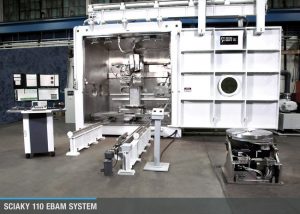 In an effort to increase the sales efforts of its Electron Beam Additive Manufacturing (EBAM) solutions in Australia, the Middle East, and New Zealand, Sciaky, Inc. has entered into an agreement with KTM Consultants, founded by metallurgist Trent Mackenzie in 2015. In terms of sheer work envelope, Sciaky’s massive EBAM systems are the industry’s most widely scalable metal 3D printing solution, able to produce parts ranging from 8 inches to 19 feet at gross deposition rates of up to 25 lbs of metal an hour. Additionally, its Interlayer Real-time Imaging and Sensing System (IRISS) is the metal 3D printing market’s only real-time adaptive control system capable of sensing and digitally self-adjusting its deposition.
In an effort to increase the sales efforts of its Electron Beam Additive Manufacturing (EBAM) solutions in Australia, the Middle East, and New Zealand, Sciaky, Inc. has entered into an agreement with KTM Consultants, founded by metallurgist Trent Mackenzie in 2015. In terms of sheer work envelope, Sciaky’s massive EBAM systems are the industry’s most widely scalable metal 3D printing solution, able to produce parts ranging from 8 inches to 19 feet at gross deposition rates of up to 25 lbs of metal an hour. Additionally, its Interlayer Real-time Imaging and Sensing System (IRISS) is the metal 3D printing market’s only real-time adaptive control system capable of sensing and digitally self-adjusting its deposition.
“I was immediately drawn to Sciaky’s EBAM technology because of its unique and robust capabilities. Industrial manufacturers of large metal parts need to explore the significant advantages that technologies like EBAM offer. It is truly a game-changer,” said Mackenzie.
Xometry Announces New Industry Certifications
 Digital manufacturing marketplace Xometry announced that it has just received ISO 9001:2015 and AS9100D certifications – some of the most rigorous, widely-recognized quality management designations in the industry. ISO 9001 helps organizations meet the needs and expectations of their customers in terms of quality management, while AS9100 meets customer demands in the exacting aerospace and defense industries. The company went through a major audit as part of the process, and its achievement definitely reflects how committed Xometry is to providing quality.
Digital manufacturing marketplace Xometry announced that it has just received ISO 9001:2015 and AS9100D certifications – some of the most rigorous, widely-recognized quality management designations in the industry. ISO 9001 helps organizations meet the needs and expectations of their customers in terms of quality management, while AS9100 meets customer demands in the exacting aerospace and defense industries. The company went through a major audit as part of the process, and its achievement definitely reflects how committed Xometry is to providing quality.
“We are thrilled to receive this designation. Our team members have a passion for providing great customer service while following the disciplines that give our customers peace of mind regarding on-time delivery, quality, and continuous improvement. It is yet another step towards achieving industry “best in class” status and being able to meet the expanded needs of our customers,” stated Xometry COO Peter Goguen.
nScrypt Develops Proprietary Method for 3D Printing Titanium
Florida manufacturer nScrypt, which develops high-precision Micro-Dispensing and Direct Digital Manufacturing equipment and solutions, is now focusing on repeatable 3D printing of metals for the medical, defense, and aerospace industries. The company has created a proprietary method for 3D printing titanium parts, which tests have shown display densities comparable to wrought parts. This method could easily work with other metals as well, such as copper, Inconel, and stainless steel, and nScrypt’s Factory in a Tool (FiT) systems can finish or polish areas with high tolerance features using its integrated precision nMill milling head. nScrypt’s Brandon Dickerson told us that the company expects to release more details on this later in 2019.
“The parts were printed with our SmartPump
Micro-Dispensing tool head, which runs on any of our systems,” Dickerson told 3DPrint.com. “The parts shown in the photos were printed on our DDM (Direct Digital Manufacturing) system, also known as our Factory in a Tool (FiT) system, which can run 5 tool heads at the same time, including our Micro-Dispensing, Material Extrusion, micro-milling, and pick-and-place tool heads. The parts were sintered after the build and the current densities are in the high 90% range. We expect our system to appeal to customers who want to do Direct Digital Manufacturing and need strong metal parts, but cannot build them with a powder bed system (for example, if the geometry would trap powder inside) or prefer not to use a powder bed system (for example, if they want a cleaner system).”
Zurich Opera House 3D Printing Props with German RepRap
Switzerland’s largest cultural institution, the Zurich Opera House, puts on over 300 performances a year, but the behind-the-scenes magic happens in the studios and workshops, where the props and costumes are made. The opera house uses the x400 3D printer from German RepRap, with assistance from Swiss reseller KVT- Fastening, to support its creative work by fabricating props and molds. This affords the institution more creativity and flexibility, as they can design objects to their exacting needs in 3D modeling programs, which also helps save on time and money. The opera house currently uses PLA, which is easy to handle, offers a variety of colors, and is flame retardant – very important in a theatrical setting.
“Often, the wishes and ideas of costume and stage designers are very diverse and sometimes extraordinary. It often happens that props are not available in the way designers have it in their minds. This is where the 3D printer is perfect for,” said Andreas Gatzka, director of theater sculpture at the Zurich Opera House.
“There are a lot of great benefits. Special wishes of stage and costume designers can be realized quickly as well as a short-term change of the objects, for example larger, smaller, longer, shorter, or whatever is needed.”
3D Printed Art Collection
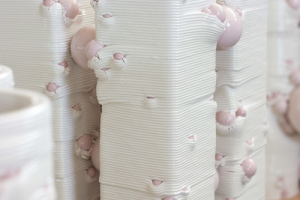 Artist Andrea Salvatori 3D printed the eye-catching pieces for his new collection, titled Ikebana Rock’n’Roll, using the Delta WASP 40100 Clay 3D printer – designed by WASP to be used by ceramic and clay artists. The collection just opened on stage at THE POOL NYC in Milan last week, and will be available to view until May 31st. With these 3D printed vases, Salvatori wanted to use “a miscellany of ceramic insertions” to mess with the high quality shapes 3D printing can achieve by adding asymmetry.
Artist Andrea Salvatori 3D printed the eye-catching pieces for his new collection, titled Ikebana Rock’n’Roll, using the Delta WASP 40100 Clay 3D printer – designed by WASP to be used by ceramic and clay artists. The collection just opened on stage at THE POOL NYC in Milan last week, and will be available to view until May 31st. With these 3D printed vases, Salvatori wanted to use “a miscellany of ceramic insertions” to mess with the high quality shapes 3D printing can achieve by adding asymmetry.
“The process of depositing the material and setting the spheres is a central theme in the Ikebana Rock’n’Roll collection, to the point of convincing Salvatori to name the works “Composition 40100”, as if they originated from a musical dialogue of the most varied tones. The artist upsets the algorithm reiterated slavishly by the machine with imperfect musical accents, the result from time to time of spontaneous actions and reasoned processes,” WASP wrote in a blog post.
“The ikebanes, proposed by Andrea Salvatori in the exhibition, transcend the experimental limits of an abstract investigation, representing a concrete territory in which 3D printing and ceramic art co-exist synergistically. The Master challenges the confrontation with the public, becoming also in this sector, precursor of a new genre in which WASP feels itself fully represented.”
Discuss these stories and other 3D printing topics at 3DPrintBoard.com or share your thoughts in the Facebook comments below.


